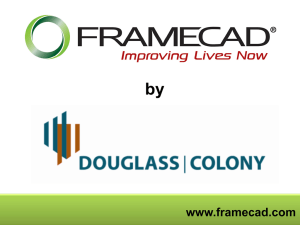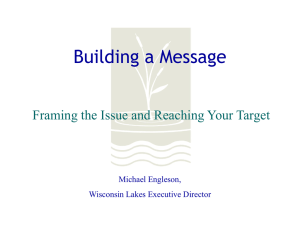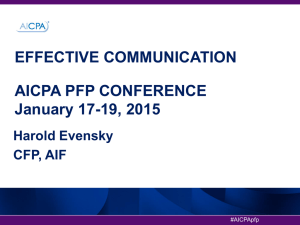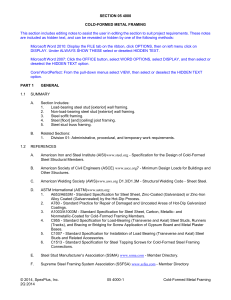06-01-14 SPEC WRITER NOTES: 1. Use this section only for NCA
advertisement
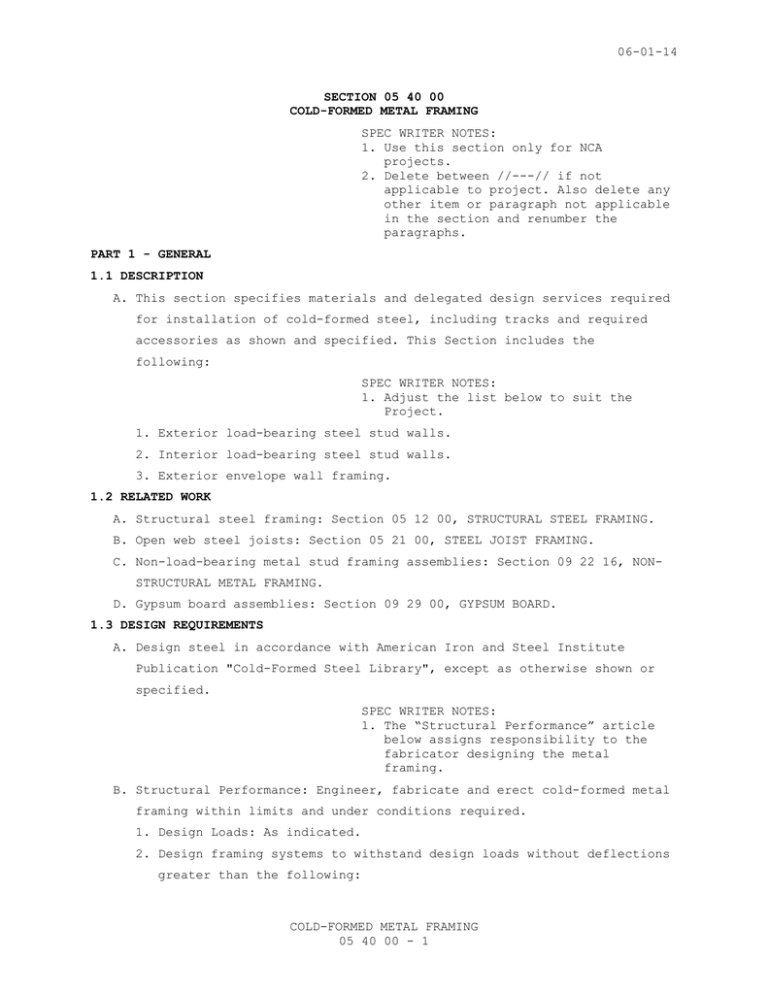
06-01-14 SECTION 05 40 00 COLD-FORMED METAL FRAMING SPEC WRITER NOTES: 1. Use this section only for NCA projects. 2. Delete between //---// if not applicable to project. Also delete any other item or paragraph not applicable in the section and renumber the paragraphs. PART 1 - GENERAL 1.1 DESCRIPTION A. This section specifies materials and delegated design services required for installation of cold-formed steel, including tracks and required accessories as shown and specified. This Section includes the following: SPEC WRITER NOTES: 1. Adjust the list below to suit the Project. 1. Exterior load-bearing steel stud walls. 2. Interior load-bearing steel stud walls. 3. Exterior envelope wall framing. 1.2 RELATED WORK A. Structural steel framing: Section 05 12 00, STRUCTURAL STEEL FRAMING. B. Open web steel joists: Section 05 21 00, STEEL JOIST FRAMING. C. Non-load-bearing metal stud framing assemblies: Section 09 22 16, NONSTRUCTURAL METAL FRAMING. D. Gypsum board assemblies: Section 09 29 00, GYPSUM BOARD. 1.3 DESIGN REQUIREMENTS A. Design steel in accordance with American Iron and Steel Institute Publication "Cold-Formed Steel Library", except as otherwise shown or specified. SPEC WRITER NOTES: 1. The “Structural Performance” article below assigns responsibility to the fabricator designing the metal framing. B. Structural Performance: Engineer, fabricate and erect cold-formed metal framing within limits and under conditions required. 1. Design Loads: As indicated. 2. Design framing systems to withstand design loads without deflections greater than the following: COLD-FORMED METAL FRAMING 05 40 00 - 1 06-01-14 SPEC WRITER NOTES: 1. Deflection limits below are examples only. Select deflection limits as appropriate for wall, floor, and ceiling finish materials. a. Exterior Load-Bearing Walls: Lateral deflection of // 1/240 // 1/360 // 1/600 // of the wall height. b. Interior Load-Bearing Walls: Lateral deflection of // 1/240 // 1/360 // of the wall height. c. Exterior Non-load-Bearing Curtain wall: Lateral deflection of // 1/240 // 1/360 // 1/600 // 1/720 // of the wall height. 3. Design framing systems to provide for movement of framing members without damage or overstressing, sheathing failure, connection failure, undue strain on fasteners and anchors, or other detrimental effects when subject to a maximum ambient temperature change (range) of 67 degrees C (120 degrees F). 4. Design framing system to accommodate deflection of primary building structure and construction tolerances, and to maintain clearances at openings. 5. Design exterior envelope wall framing to accommodate lateral deflection without regard to contribution of sheathing materials. 6. Fire-Test-Response Characteristics: Where indicated, provide cold- formed metal framing identical to that of assemblies tested for fire resistance per ASTM E 119 by a testing and inspecting agency acceptable to authorities having jurisdiction. 7. Seismic Loads: Design and size components to withstand seismic loads and sway displacement as in accordance with code. 8. Engineering Responsibility: Engage a qualified professional engineer who assumes undivided responsibility for engineering cold-formed metal framing, prepares design calculations, shop drawings, and other structural data. C. Welding in accordance with AWS D1.3. D. Furnish members and accessories by one manufacturer only. 1.4 SUSTAINABILITY REQUIREMENTS A. Materials in this section may contribute towards contract compliance with sustainability requirements. See Section 01 81 11, SUSTAINABLE DESIGN REQUIRMENTS, for project // local/regional materials, // lowemitting materials, // recycled content, // _____// requirements. COLD-FORMED METAL FRAMING 05 40 00 - 2 06-01-14 1.5 SUBMITTALS A. Submit in accordance with Section 01 33 23, SHOP DRAWINGS, PRODUCT DATA, AND SAMPLES. B. Shop Drawings: 1. Show layout, spacing, sizes, thicknesses, and types of cold-formed metal framing; fabrication, fastening and anchorage details, including mechanical fasteners. 2. Show reinforcing channels, opening framing, supplemental framing, strapping, bracing, bridging, splices, accessories, connection details, and attachment to adjoining work. 3. Include seal of the qualified professional engineer responsible for their preparation. C. Delegated-Design Submittal: For cold-formed metal framing indicated to comply with design loads, include structural analysis data signed and sealed by the qualified professional engineer responsible for their preparation. D. Qualification Data: For professional engineer demonstrating license to practice in location of their practice. 1.6 PRE-INSTALLATION CONFERENCE A. Convene a meeting on site, after submittals are received and approved but before any work, to review drawings and specifications, submittals, schedule, manufacturer instructions, site logistics and pertinent matters of coordination, temporary protection, governing regulations, tests and inspections; participants to include RE/COR and all parties whose work is effected or related to the work of this section. 1.7 APPLICABLE PUBLICATIONS A. Publications listed below form a part of this specification to extent referenced. Publications are referenced in text by the basic designation only. Comply with applicable provisions and recommendations of the following, except as otherwise shown or specified. SPEC WRITER NOTES: 1. Remove reference citations that do not remain in Part 2 or Part 3 of edited specification. 2. Verify and make dates indicated for remaining citations the most current at date of submittal; determine changes from date indicated on the TIL download of the section and modify requirements impacted by the changes. COLD-FORMED METAL FRAMING 05 40 00 - 3 06-01-14 B. American Iron and Steel Institute (AISI): Design of Cold-Formed Steel Structural Members (2010) C. American Society of Testing and Materials (ASTM): A36/A36M-12 Carbon Structural Steel A123/A123M-12 Zinc (Hot-Dip Galvanized) Coatings on Iron and Steel Products A153/A153M-09 Zinc Coating (Hot-Dip) on Iron and Steel Hardware A307-12 Carbon Steel Bolts, Studs, and Threaded Rod 60,000 PSI Tensile Strength A653/A653M-11 Steel Sheet, Zinc-Coated (Galvanized) or ZincIron Alloy-Coated (Galvannealed) by the Hot-Dip Process A780/A780M-09 Repair of Damaged and Uncoated Areas of Hot Dipped Galvanized Coatings A1003/A1003M-13a Steel Sheet, Carbon, Metallic- and Non-metallic coated for Cold Form Metal Framing Members C955-11c Load-Bearing (Transverse and Axial) Steel Studs, Runners (Tracks), and Bracing or Bridging for Screw Application of Gypsum Panel Products and Metal Plaster Bases C1107/C1107M-13 Packaged Dry, Hydraulic-Cement Grout (Nonshrink) C1513-12 Steel Tapping Screws for Cold-Formed Steel Framing Connections E119-12 Test Methods for Fire Tests of Building Construction and Materials E488/E488M-10 Test Methods for Strength of Anchors in Concrete Elements E1190-11 Test Methods for Strength of Power-Actuated Fasteners Installed in Structural Members F1941-10 Electrodeposited Coatings on Threaded Fasteners (Unified Inch Screw Threads (UN/UNR)) D. American Welding Society (AWS): D1.3/D1.3M:2008 Structural Welding Code-Sheet Steel E. Military Specifications (Mil. Spec.): MIL-P-21035B COLD-FORMED METAL FRAMING 05 40 00 - 4 06-01-14 (Reinst. Notice 2) Paint, High Zinc Dust Content, Galvanizing Repair F. Society for Protective Coatings (SSPC): SSPC-Paint 20 - Zinc-Rich Primers (Type I, "Inorganic," and Type II, "Organic") PART 2 - PRODUCTS 2.1 MATERIALS SPEC WRITER NOTES: 1. Select G60 or G90 coating. The Brick Industry Association recommends G90 for stud backup for brick veneer applications. A. Sheet Steel for studs and other structural elements: ASTM A1003, structural grade, zinc coated Z180 (G60), with a yield of 340 MPa (50 ksi) minimum. B. Sheet Steel for accessories: ASTM A653 or ASTM A1003, zinc coated // G60 // G90 //, with a yield of 230 MPa (33 ksi) minimum. C. Galvanizing Repair Paint: MIL-P-21035B or SSPC - Paint 20. 2.2 WALL FRAMING A. Framing components must comply with ASTM C955 and the following. SPEC WRITER NOTES: 1. Select the steel thickness as required. 2. Sequence corresponds to 20 gage, 18 gage, 16 gage, 14 gage, and 12 gage thicknesses. B. Steel Studs: Manufacturer’s standard C-shaped steel studs of web depth indicated, with lipped flanges, and complying with the following: 1. Minimum Base Metal: //0.91 mm (0.0358 inch)// //1.20 mm (0.0474 inch)// //1.52 mm (0.0598 inch)// //1.90 mm (0.0747 inch)// //2.66 mm (0.1046 inch)// C. Steel Track: Manufacturer’s standard U-shaped steel track, unpunched, of web depths indicated; minimum base metal thickness matching steel studs. 2.3 FRAMING ACCESSORIES SPEC WRITER NOTES: 1. Revise minimum yield strength of accessories as required. COLD-FORMED METAL FRAMING 05 40 00 - 5 06-01-14 A. Fabricate steel framing accessories of the same material and finish used for framing members, with a minimum yield strength of 230 MPa (33 ksi). B. Provide accessories of manufacturer’s standard thickness and configuration, unless otherwise indicated, as follows: SPEC WRITER NOTES: 1. Revise list below to suit project. 1. Supplementary framing. 2. Bracing, bridging, and solid blocking. 3. Web stiffeners. 4. Gusset plates. 5. Deflection track and vertical slide clips. 6. Stud kickers and girts. 7. Reinforcement plates. 2.4 CONNECTIONS A. Provide screws for steel-to-steel connections as self-drilling or tapping screws in compliance with ASTM C1513 of the type, size and location shown on the shop drawings. B. Electroplated screws to have a minimum 5 micron zinc coating in accordance with ASTM F1941. C. Screws, bolts, and anchors to be hot-dipped galvanized in accordance with ASTM A123 or ASTM A153 as appropriate. D. Screws, bolts, and anchors to be hot dipped galvanized in accordance with ASTM A123 or ASTM A153 as appropriate. 2.5 PLASTIC GROMMETS A. Supply plastic grommets, recommended by stud manufacturer, to protect electrical wires. B. Prevent metal to metal contact for plumbing pipes. 2.6 ANCHORS, CLIPS, AND FASTENERS A. Steel Shapes and Clips: ASTM A36, zinc coated by the hot-dip process according to ASTM A123. B. Cast-in-Place Anchor Bolts and Studs: ASTM A307, Grade A, zinc coated by the hot-dip process according to ASTM A153. C. Expansion Anchors: Provide products fabricated from corrosion-resistant materials, with capability to sustain, without failure, a load equal to 5 times the design load, as determined by testing per ASTM E488 conducted by a qualified independent testing agency. COLD-FORMED METAL FRAMING 05 40 00 - 6 06-01-14 D. Power-Actuated Anchors: Provide fastener system of type suitable for application indicated, fabricated from corrosion-resistant materials, with capability to sustain, without failure, a load equal to 10 times the design load, as determined by testing per ASTM E1190 conducted by a qualified independent testing agency. E. Mechanical Fasteners: Corrosion-resistant coated, self-drilling, selfthreading steel drill screws; low-profile head beneath sheathing, manufacturer’s standard elsewhere. F. Welding Electrodes: Comply with AWS Standards. PART 3 - EXECUTION 3.1 FABRICATION A. Framing components may be preassembled into panels; fabricate panels square with components attached. B. Cut framing components squarely or as required for attachment. Cut framing members by sawing or shearing; do not torch cut. C. Hold members in place until fastened. D. Fasten cold-formed metal framing members by welding or screw fastening, as standard with fabricator; wire tying of framing members is not permitted. 1. Comply with AWS requirements and procedures for welding, appearance and quality of welds, and methods used in correcting welding work. 2. Locate mechanical fasteners and install according to cold-formed metal framing manufacturer’s instructions with screw penetrating joined members by not less than 3 exposed screw threads. E. Where required, provide specified insulation in double header members and double jamb studs which will not be accessible after erection. 3.2 INSTALLATION A. General: 1. Install cold-formed framing in accordance with ASTM C1107 and AISI S200. 2. Install cold-formed steel framing according to AISI S202 and to manufacturer's written instructions unless more stringent requirements are indicated. B. Securely anchor tracks to supports as shown. C. At butt joints, securely anchor two pieces of track to same supporting member or butt-weld or splice together. D. Plumb, align, and securely attach studs to flanges or webs of both upper and lower tracks. COLD-FORMED METAL FRAMING 05 40 00 - 7 06-01-14 E. Align axially loaded members vertically to allow for full transfer of the loads down to the foundation; maintain vertical alignment at floor/wall intersections. F. Provide at least two studs at jambs of doors and other openings 600 mm (2 feet wide) or larger. G. Install jack studs above and below openings and as required to furnish support. Securely attach jack studs to supporting members. H. Install headers in all openings that are larger than the stud spacing in that wall. I. Building Envelope Construction: 1. Provide for vertical movement where studs connect to the structural frame. 2. Provide horizontal bracing in accordance with the design calculations and AISI SG03-3, consisting of, as a minimum, runner channel cut to fit between and welded to the studs or hot- or coldrolled steel channels inserted through cutouts in web of each stud and secured to studs with welded clip angles. 3. Minimum Bracing: LOAD Wind load only HEIGHT Up to 3000 mm (10 BRACING One row at mid-height feet) Axial load Over 3000 mm (10 Rows 1500 mm (5'-0") o.c. feet) maximum Up to 3000 mm (10 Two rows at 1/3 points feet) Over 3000 mm (10 Rows 900 mm (3'-4") o.c. feet) maximum J. Attach bridging for studs in a manner to prevent stud rotation. //Space bridging rows as shown. // K. Provide studs in one piece for their entire length; splices will not be permitted. L. Provide temporary bracing and leave in place until framing is permanently stabilized. M. Do not bridge building expansion joints with cold-formed metal framing. Independently frame both sides of joints. N. Fasten reinforcement plate over web penetrations that exceed size of manufacturer’s standard punched openings. COLD-FORMED METAL FRAMING 05 40 00 - 8 06-01-14 3.3 TOLERANCES A. Vertical Alignment (plumbness) of Studs: Within 1/960th of the span. B. Horizontal Alignment (levelness) of Walls: Within 1/960th of their respective lengths. C. Spacing of Studs: Not be more than 3 mm (1/8 inch) +/- from the designed spacing providing that the cumulative error does not exceed the requirements of the finishing materials. 3.4 FIELD QUALITY CONTROL A. Testing: Engage a qualified independent testing and inspecting agency to perform field tests and inspections and prepare test reports. 1. Test and inspect field and shop welds. 2. Perform inspections in order to assure strict conformance to the shop drawings at all phases of construction. 3. Check members for proper alignment, bearing, completeness of attachments, proper alignment, reinforcement, etc. B. Testing agency must report test results promptly and in writing. C. Remove and replace work where test results indicate that it does not comply with specified requirements. D. Additional testing and inspecting, at Contractor's expense, will be performed to determine compliance of replaced or additional work with specified requirements. 3.5 FIELD REPAIR A. Touch-up damaged galvanizing with galvanizing repair paint complying with ASTM A780. - - - E N D - - - COLD-FORMED METAL FRAMING 05 40 00 - 9


